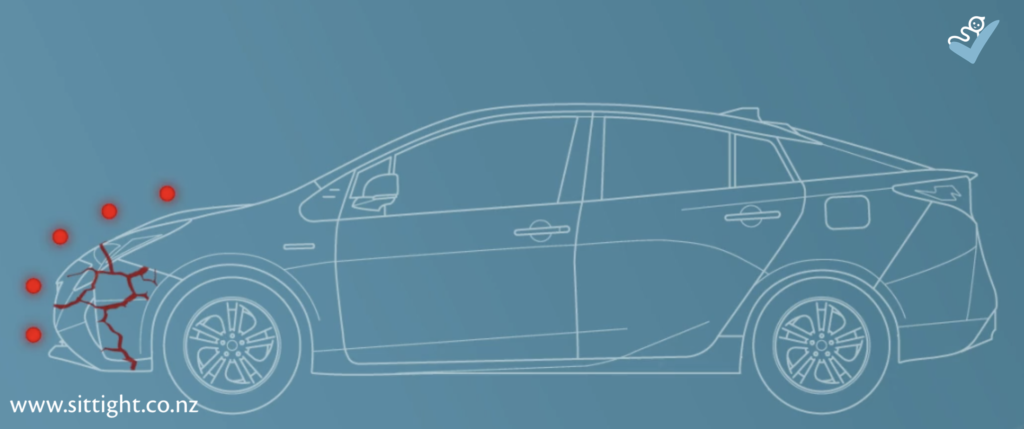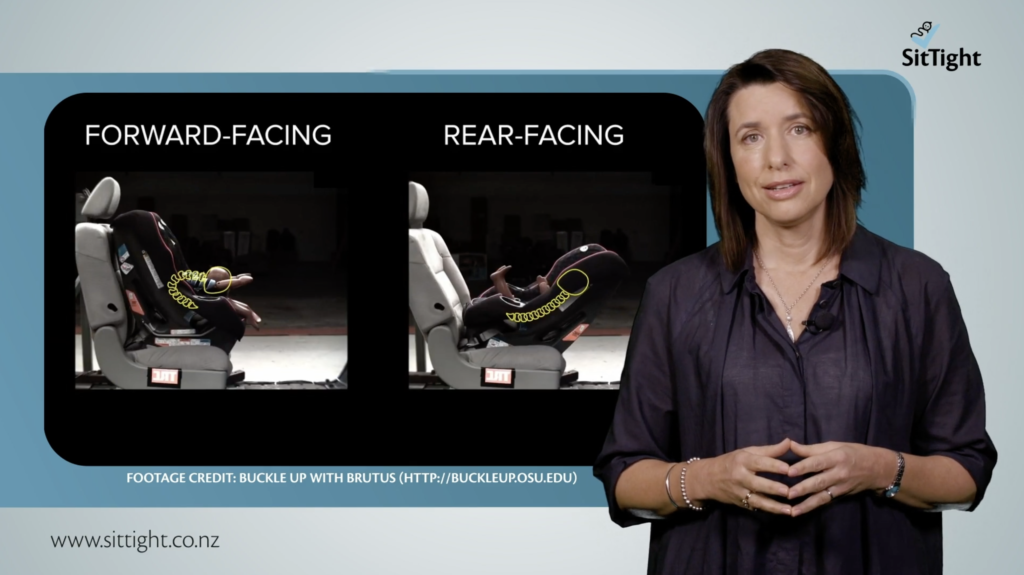In a crash, a rear-facing car seat provides vital support to a child’s head, neck and spine. It’s that simple.
Let’s expand on this to understand it further.
Most Common Crash Point
Working with statistics, we know that the majority of crashes take place at the front of the vehicle. This is called a “frontal crash”.
A frontal crash often generates the most force through a vehicle. This force is one of the main things we are protecting a child from.
The force generated by a frontal crash, “throws” everything in the vehicle forwards with enormous momentum. This includes a child in a child restraint.

Benefit of Rear-Facing Car Seat
In a rear-facing car seat, the force from a frontal crash pushes the child into the shell of their car seat. This cradles their body from head to toe. In turn, the crash forces are absorbed across a wide area of the child’s body. When the crash forces are at their greatest, a baby’s head, neck and spine are fully supported by the child restraint.
The benefit of this is that it reduces the risk of severe head, neck and spinal injuries.
Outcome of Forward-Facing Car Seat
Now imagine that the child restraint is installed in a forward-facing direction in that same frontal crash.
The impact from the crash sends the child’s body forward at great force but, in a forward-facing child restraint, there is no outside support to stop the forward movement. The only thing stopping a child’s head moving forward at force is their neck and spine. It goes without saying that this causes severe neck and spinal injuries, or worse.
Fact: It takes just 6mm of stretch for a young child’s spinal cord to be at risk of rupturing.

We mentioned above that a rear-facing car seat spreads the crash forces, allowing them to be absorbed by a wide area of the child’s body. The crash forces are always absorbed by the area of the body at which the forward momentum is being stopped – in the case of a forward-facing restraint, the car seat’s harness is what is stopping the forward momentum of the child’s body. So the full impact of the crash is absorbed by the very small area of the body directly beneath the harness, putting immense pressure on very specific areas.
Bear in mind, the harness doesn’t stop the head moving forward. As we mentioned above, the spine takes the full force of the head’s forward momentum.
Adults also have to withstand the same forces generated by a frontal crash, but there are many reasons why the injuries sustained by adults in these circumstances are less severe than those suffered by children.
The types of head, neck and spinal injuries sustained by a child in a forward-facing restraint have far-reaching and long-lasting consequences.
How long should a child be in a rear-facing car seat?
It is recommended that you keep a child rear-facing until at least 2 years old, but longer if possible.
Always read the limits of your child restraint. If your car seat doesn’t allow your child to rear-face until 2 years, then it is best to look for another car seat which does.
Once a child has reached 2 years old and is still in a rear-facing car seat, then best practice is to keep a child rear-facing until they have outgrown the rear-facing limits of their car seat. In some cases, this is much older than 2 years old, and this is safest.
Many children now stay in a rear-facing car seat until they are 4-6 years old. There are plenty of seats on the market which will allow this, and it is safest.
Is a child uncomfortable in a rear-facing car seat?
The first question that comes to mind when thinking of a 4-6-year-old in a rear-facing car seat is, “Where will their legs go? Will they be uncomfortable?”. The answer is almost always, “Their legs will bend and no, they won’t be uncomfortable.” To be reassured on this, read our article where we explain this further.
What does NZ car seat law say about rear-facing?
Part 7 of the Land Transport Road User Rule, which governs how we transport children in New Zealand, doesn’t specifically refer to rear-facing. However, to comply with NZ car seat law you must follow the instruction manual of the particular child restraint you are using. If yours is a rear-facing car seat, the instruction manual will state at what weight and/or height and/or age a child must use it in a rear-facing position. If your child is within those limits then, by law, they must use the car seat in a rear-facing position.
Summary
Don’t assume that because your child is in the higher percentile for height or weight that they are strong enough to be forward-facing. The human body, at whichever age, is far better protected from frontal crash forces in a supported rear-facing position.
You’re always welcome to make contact with us at SitTight to ask questions about the correct, safe and legal use of child restraints. Or you can follow us on Facebook or Instagram.